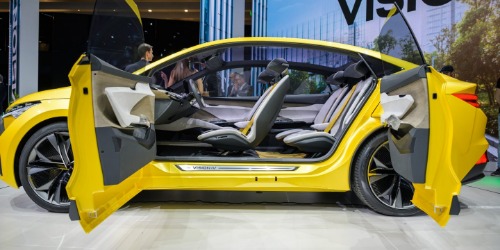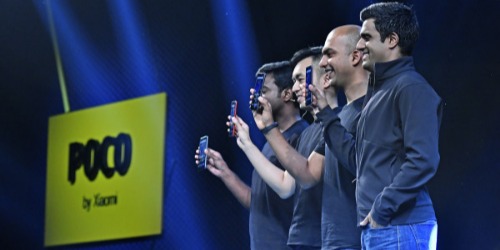Skoda’s First Electric SUV To Be Called Enyaq

Skoda Auto today revealed that its first electric SUV will be presented soon. It in fact let out what it will be called. Skoda will call it the Enyaq and yes even we want to know where that name comes from. According to the company, the name Enyaq is based in the Irish language and expresses the vehicle's dynamism and efficiency. The Enyaq then opens a new chapter in the 125-year history of the Skoda brand. It will be Skoda's first electric car which will be built on the MEB platform, and will also launch a new family of model names. Of course, Skoda already has an electric car to its name, the Citigo iV and so it's not new to the EV space, however, the all-electric SUV will definitely ind it a wider appeal.
Skoda SUVs have traditionally had names ending in the letter Q, and the new Enyaq follows this tradition just like the Kamiq, Kodiaq and the Karoq. But the new model's first letter shows that this tradition is merging with the eMobility era, referenced by the letter E at the beginning of the name. The name, Enyaq, is derived from the Irish name Enya, which means 'source of life',
We'll know more about the electric SUV very soon, but it's clear why the company wants to start its journey in the electric mobility space with an SUV. Well, the clear trend setters now are the SUVs globally and so this decision does not come as a surprise. As to which markets the Enyaq will be introduced? Well, there's no clarity on that yet and we'll know more very soon.
- 0
- Leave a comment
5G is seen as a game-changer for India

5G is around the corner...and there is an ever-increasing euphoria amongst the Telecom Service Providers (TSPs), the TMT ecosystem and the consumer community at large at the vast opportunities 5G will bring. Simply put, 5G is expected to be significantly smarter, faster and efficient compared to its legacy 3G and 4G predecessors. For instance, it holds a promise of 100 times more speed relative to 4G networks. The possibilities, with a network like this, are unfathomable.
The launch of 5G-enabled technologies is expected to be transformative in the telco and other industries by unlocking various disruptive new technologies. Global investment in the 5G industrial chain over 2020-2035 is likely to reach US$ 3.5 trillion. More than US$12 trillion sales are expected to be generated by global industry applications driven by 5G technology.
5G has the potential to become the world's predominant LAN and WAN technology over the couple of decades, especially in green-field rollouts. Organisations building new factories, ports, or campuses can significantly reduce their usage of wired connections. The next five years will likely see a boom in private 5G implementations at locations that would greatly benefit from better wireless technology-in terms of speed, capacity, latency, and more. Application and installation of the Private Networks could vary from a manufacturing facility, buildings, large campuses, notified or designated locations within geographies, healthcare and in mining sectors for autonomous mobility in areas where it is dangerous for humans to enter.
Closer to home, we expect significant application in 5G enabled internet of things - across smart cities and industry 4.0 use cases. Globally, these two areas account for nearly 44 per cent of 5G applications. Other applications likely to gain scale in India at a later date with enhancement in the coverage and technology are sensor based crop monitoring, remote machinery control, surveillance, energy management and smart transport.
In a recent digital competitiveness ranking survey conducted by Institute for Management Development (IMD) in 2019, India ranked at 48th out of a total of 63 economies. However, recent events such as demonetisation and low mobility price points are leap-frogging India in a pervasive digital adoption. India's digital communication policy is trying to create a conducive environment to promote investments, and policy support to increase the digital footprint. The current policies set directions to lay foundations for the 5G ecosystem with the aim to:
- Enhance contribution of the digital communication sector to 8 per cent of the India's GDP
- Propel India to the top 50 nations in the ICT development index of ITU
- Policy landscape to steer the growth of digital revolution - National Digital Communication Policy (NDCP) 2018 aiming at US$ 100 billionn investment in the sector and ensuring broadband coverage at 50 mbps for every citizen, Draft Cloud Computing policy, Electronic Development Fund (EDF) policy, National Manufacturing policy and Preferential Market Access (PMA)
Through building partnerships, R&D investments and network trials, industry-specific service requirements are being currently assessed that will require high data-rate communication, low latency, and massive connectivity. 5G is being seen as a likely game changer for India, with the potential to create an economic impact of more than US$1 trillion by 2035.
India is keen to board the 5G bus sooner than later. The task before India's policy makers will be ensure that the advantages of the telecom infrastructure and related technologies supports its divergent demography, economic conditions and urbanisation. Key areas to focus will include:
- Reasonable spectrum pricing and swift allocation of spectrum
- Policy framework enabling extensive fiberisation and incentivisation to share fiber networks
- Push for "Make in India" manufacturing for 5G equipment and handsets
- Tailor made 5G use cases and applications enabled through active trials
- Indigenous technology advancements through R&D, and IPR development for standards, technology, spectrum, and security
- Public-private partnerships for broadband growth and penetration, 5G trials and testing, network densification among others
Higher frequency 5G networks will demand a deeper densification of networks. The key enabler for seamless experience will be a robust fiber backhaul. Eighty per cent of India's current mobile network rides over radio as opposed to that of US and China at 20 per cent. Hence, it would be imperative for the government investment and policies to support fiber densification to reap maximum benefits of the technology.
The Government is very keen to jumpstart the 5G Commercial launch in India and enhance the national broadband footprint. Supported by the existing talent across the TMT industry, India has the opportunity to mature its ICT portfolio and unlock mega monetization opportunities. To achieve these macro objectives in a better way, the telecom sector does need a helping hand...right now. As such, the Government can take some definitive steps to create an environment that provides the necessary impetus for next evolution of growth in the sector and resolve some long outstanding issues.
Samsung unveils 'smart almirah' that can clean, iron your clothes

Samsung Electronics has launched an innovative 'almirah' that can clean and iron clothes. This smart almirah is known as AirDresser that uses air and steam to clean clothes hung inside it.
"This latest home laundry solution AirDresser uses powerful air and steam to remove dust and germs, refreshing and sanitizing clothes to provide easy and convenient garment care," the electronic giant said.
Jet Air and Air Hangers release powerful air that help in removing dust from clothes hung inside the AirDresser. Unlike a usual washing machine, the appliance makes minimal noise and vibration when operated under quiet mode.
JetSteam sanitises garments to get rid of bacteria, viruses. AirDresser uses 'Deodorizing Filter' function to freshen clothes. According to the technology giant, the AirDresser removes 99.9 percent of harmful bacteria, viruses, odors and wrinkles of any cloth.
Meanwhile, its 'Self Clean' technology dehumidifies, sanitises, and deodorises the interior of the AirDresser without any use of detergents. It is only the combination of heat, air and steam that helps in cleaning the clothes. Moreover, the AirDresser features portable water containers for steam at the bottom, so it doesn't require a water supply or drainage system.
So far, Samsung has only released the pictures of AirDresser without any price details.
Microsoft introduces Math Solver app, uses AI to solve problems

Microsoft is making solving mathematic problems a little easier. The Redmond-headquartered technology giant has introduced an AI-based Math Solver application that can be used to solve math problems on a smartphone or a tablet. Microsoft says that the app can be used to help with a wide range of mathematical concepts-from elementary arithmetic and quadratic equations to calculus and statistics.
Available for iOS and Android platform, the user can use the smartphone camera to capture an image of the mathematical problem or can even scribble the math problem on the smartphone or the tablet's display.
How does it work?
According to Microsoft, the Math Solver uses Artificial Intelligence (AI) to instantly recognise the problem and deliver an accurate solution. The app can also be used as a mathematical learning aid for students as it will also provide a step-by-step explanation with additional learning materials such as worksheets and video tutorials. It also provides interactive graphs to help learners understand the correlation. On the app, users can scan and plot X-Y data tables for linear or non-linear functions. With interactive definitions and explanations, students can easily grasp and retain concepts better.
Supported problems on the Math Solver app include elementary (arithmetic, real, complex numbers, LCM, GCD, factors, roman numerals), pre-algebra (radicals and exponents, fractions, matrices, determinants), algebra (quadratic equations, system of equations, inequalities, rational expressions, linear, quadratic and exponential graphs), basic calculus (summations, limits, derivatives, integrals), statistics (mean, median, mode, standard deviation, permutations, combinations) and word problems on math concepts, number theory, probability, volume, surface area.
How to use?
Interestingly, the Math Solver application supports a wide range of inputs - draw, scan or type. A user can simply draw on the device's display with a finger or use a stylus. As the application is AI-powered, it will recognise the handwriting and show the problem instantly in text form. The second method is to capture the photo of the equation and upload the image in the application. Alternatively, there is a provision to type the problem statement, using the scientific calculator in the app.
The app has a neat user interface with the scan, draw and type option on the centre top. On the top left is the notes icon that shows the list of problems that a user can try. This includes problems across fractions, rational equation, radical equation, logarithmic equation, arithmetic, trigonometry, differentiation and more.
Which languages does it support?
Microsoft's Math Solver application supports a wide range of languages. Of the 22 languages support, it includes 12 Indian languages namely Assamese, Bengali, Gujarati, Hindi, Kannada, Konkani, Marathi, Malayalam, Oriya, Punjabi, Tamil, and Telugu. Some of the international languages supported include German, Spanish, Simplified Chinese, and Russian.
Xiaomi spins off POCO as an independent brand

Xiaomi on Friday announced its plan to turn its sub-brand POCO into an independent brand. Introduced in August 2018, POCO was led by Jai Mani, the product head of the POCO, who exited the company in July 2019. "There has been an important change in the company structure with POCO spinning off as a standalone brand. With this restructuring, POCO will run independently of with its own team and go to market strategy," says the press release issued by Xiaomi.
Manu Jain, Xiaomi Vice President and Xiaomi India Managing Director, says, "What started as a sub-brand in POCO has grown into its own identity in a short span of time. POCO F1 is an extremely popular phone across user groups, and remains a top contender in its category even in 2020. We feel the time is right to let POCO operate on its own now, which is why we're excited to announce that POCO will spin off as an independent brand. Join me in wishing the POCO team the best!"
The POCO F1 was a mid-budget flagship smartphone powered by the flagship Qualcomm 845 processor and featured a 12-MP primary sensor with f/1.9 aperture and the 5-MP depth sensor with f/2.0 aperture. Priced aggressively at Rs 20,990 for the 6GB variant, it gave tough competition to Asus Zenfone 5Z and OnePlus 6.
Earlier this week, Xiaomi shared its plans for a renewed focus on its Mi sub-brand along with Redmi in the Indian market. The company intends to launch products across categories including the ultra-premium smartphones and Mi Home portfolio. Until now, the focus had been on the Redmi series, which has helped the company garner popularity as well as the market share in the Indian market.
Raghu Reddy, Head of Categories, Xiaomi India explained, "Post 2017 we've not launched anything in the Mi smartphone portfolio, except the Mi A-series that has continued from 2017 to 2019. A large part of our business has been built on the Redmi portfolio whereas Mi has been conspicuously absent. We believe that the market is now significantly bigger than what it was two or three years ago for us to start treating it as big enough opportunity to go after. From the organisation's standpoint, we are a lot more stable and organised in 2020 compared to 2017. Going into 2020, we are organising ourselves the way we are organised in China, where there is a distinct focus on Redmi and Mi as sub-brands. So, with 2020, you will see us getting into the market with more of premium flagship devices in India.
According to CMR India Mobile Handset Market Review Report for the third quarter of 2019, while Xiaomi continues to be the market leader in smartphone shipments in the country, its growth declined by 2 per cent year-on-year. The Redmi 7A, Redmi Note 7 Pro and Redmi Note 7S together contributed more than 50 per cent to its overall shipments. The company even saw positive growth for Redmi K20 series that contributed 13 per cent to its overall shipments of premium smartphones. On the other hand, the BBK Group, the parent company of OPPO, Vivo, Realme, and OnePlus, achieved a record high of 42 per cent in Q3 2019, registering a 23 per cent year-on-year growth.


